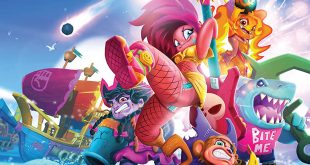Generation Media’s assistant media executive Joe Phelan investigates the growing toys-to-life craze and the ad support accompanying its continued rise during 2015/16.
As gaming sits on the precipice of VR, it is more apparent than ever that the way we interact with gaming media is consistently evolving.
Over the past few years, toys-to-life has continued its momentum and established itself as a genuine presence amongst gaming in the kids market. Of the Top Ten gaming titles in 2015, four fell into the toys-to-life category, double the number of 2014. Skylanders Superchargers achieved 2,084 children TVRs and reached over 76 per cent of kids in the UK. By making use of the kids commercial channels such as the Nickelodeon and Disney portfolios, these brands have been able to further access and influence this demographic. With titles such as Disney Infinity (which increased its ad spend by five per cent in 2015) incorporating IPs with proven track records amongst kids such as Star Wars and Marvel, the range of toys-to-life titles is more expansive than ever.
When investigating how the toys-to-life sub category has managed to build and establish such an effective relationship with kids, it is essential to observe the genres heavy hitters; Skylanders, Disney Infinity, LEGO Dimensions and Anki Overdrive. Looking at the figures from the past full 12 months, Activision’s Skylanders brand boasts over 60 per cent share of voice in the sub-genre amassing a substantial 3,615 children aged four to 15 TVRs and averaging 157 TVRs over its 23 week burst. Disney Infinity and LEGO Dimensions provide alternate options for action figure-based games and still managed to reach an impressive amount of kids over the period, 74 per cent and 72 per cent respectively.
Meanwhile, Anki Overdrive has provided a fresh take on the genre, with an engaging racing entry. While a console is not required to play, the physical race track is controlled purely through an app. Released in October, Overdrive delivered 686 children aged four to 15 TVRs, averaging 57 children aged four to 15 TVRs over 12 weeks. In addition, each of these toy-to-life franchises adopted 20 and 30-second TV creatives in their campaigns. While this may suggest a pattern amongst the category it is most probable that these time lengths were chosen in line with the standard practices within the industry.
Licensed traditional toys from established game brands also received considerable TV support over the period. Pokmon is a mainstay amongst toys and games with popularity that doesn’t appear to ever fade. In 12 months, it achieved 1,993 children aged four to 15 TVRs through its range of action figures/trading cards and was able to reach 78 per cent of children. World of Warriors action figures also enjoyed a successful period, with 717 children aged four to 15 TVRs. Though it may not have the significant investment of the Pokmon range, the campaign over this period still managed to reach 58 per cent of children.
The toy-to-life train shows no signs of stopping and clearly is very TV reactive amongst children of all ages. The genre provides a stepping stone between traditional gaming and VR by integrating traditional play with toys and video gaming. The question is, when VR is openly accessible amongst consumers, will this impact the performance of toy-to-life games? Or will these games and accessories join the mountain of gaming peripherals that have been edged out by advancements in tech?

 MCV/DEVELOP News, events, research and jobs from the games industry
MCV/DEVELOP News, events, research and jobs from the games industry



